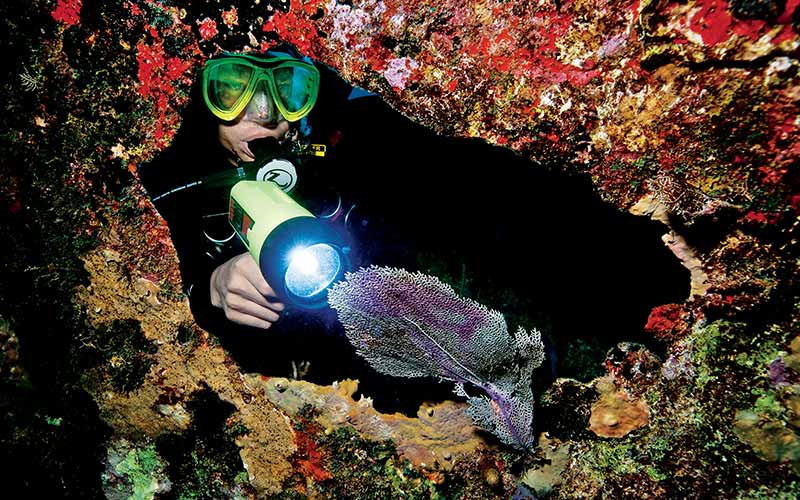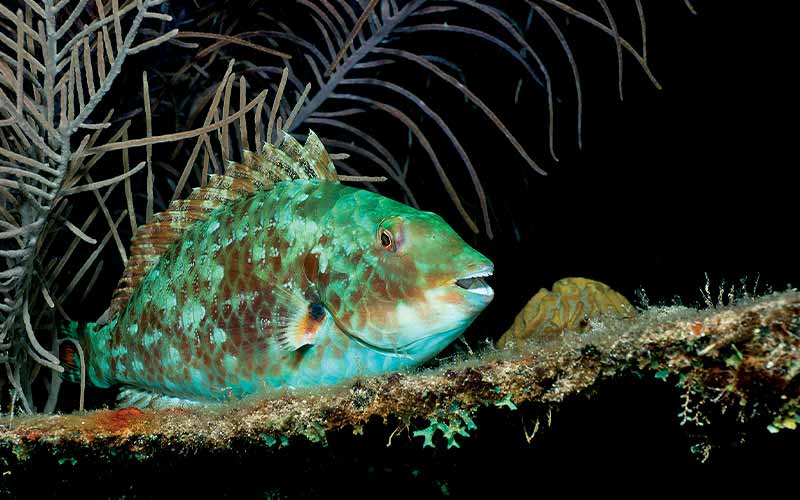As divers gain experience, we begin looking for new ways to explore, and night diving is one of the simplest and most exciting ways to do so. Diving at night opens a door to a new world of adventures, even when visiting a site you have dived dozens of times before. Many of the changes you’ll notice are the result of a shift in the environment’s inhabitants; nocturnal creatures emerge, while familiar daytime friends disappear. Other changes are in the diver’s new perspective. In daylight, especially when there is good visibility, divers tend to look at a big picture. We see whole swaths of the reef and frequently miss many of the smaller but equally interesting segments of the environment. The limited visibility at night tends to narrow our focus.
Of course, few activities induce as much anxiety for the uninitiated diver as a first night dive. Diving in a situation where total visibility is reduced to the size of a flashlight beam can be very unnerving, especially for divers who may already have some fears about the underwater environment. As with daytime fears, though, the nighttime fears are usually unwarranted. A little preparation, some additional gear and experience will make your nighttime diving as carefree and enjoyable as great dives in the daylight.

Get Ready
As with any other advanced diving activity, the best way to maximize enjoyment of a night dive is through proper preparation. Start long before the dive by ensuring your equipment is serviced, you are mentally and physically prepared and your skills are up to date through either recent diving or a scuba tuneup with a qualified instructor. Next, add a few items to your equipment setup. Obviously you will want a quality dive light (more on that later), but you will also want some extra pieces of safety gear. Every diver should use a surface marker buoy (SMB), or “safety sausage,” and a sonic alert device. As with all other equipment, ensure these devices are in working order.

It’s also a good idea to attach a small marker light to your tank valve. Many divers and dive operators use disposable Cyalume glow sticks, but there are a number of more environmentally friendly solutions (assuming you dispose of batteries properly), including battery-powered lights and even a regulator yoke screw with a small LED in the handle. The light produced by these items is unobtrusive and can assist a dive leader or dive buddy in keeping track of where you are above and below the surface. Many SMBs now include a small pocket at the top of the bag that can be used to hold a light or Cyalume stick aloft, making you much more visible on the surface in the dark. Finally, a small strobe light is a great addition to your safety gear anytime, but it is invaluable as a surface locating device at night.
In addition to checking your gear, assemble it and test your ability to deploy it before it’s actually needed. For example, it is best to insert a Cyalume glow stick in the top of your safety sausage before rolling it and attaching it to your BCD. This reduces the possibility of losing the stick in an emergency or during your dive, and it is very easy to activate the light while it is attached. Put a quick-connecting clip on the lanyard of your strobe and preselect an attachment location such as a shoulder D-ring or the low-pressure inflator hose of the BCD (add a small loop of nylon twine if necessary). Remember that the strobe needs to be above water to be effective, and the lanyard should be as short as possible to avoid entanglements; preplanning is important.
As you would for any dive, make a dive plan, and discuss it in advance with your buddy; in addition to all the usual elements it should include a review of nighttime hand and light signals. Night vision is important during a dive, so always avoid blinding another diver or the boat crew; don’t point your flashlight directly at them. It is more effective to use light signals directed near your buddy’s light beam since this is probably where he is already looking. Make a big round circle with your light to ask if he is OK. A circle back is an affirmative reply. A quick up-and-down motion is a good way to get attention, and a repeated back-and-forth motion indicates there is a problem. Modified signals are also useful on the surface; when signaling the boat make an OK using both arms just as you would in the daytime, but hold the light and point it straight down toward the top of your head. To signal for assistance point the light straight into the air and wave it back and forth. Some communications will require more traditional hand signals; do these by pointing your light down and holding your hand in the beam. But as hand signals tend to have “dialects,” so do light signals; be sure to review them with buddies and boat crews before your dive.
Night Lights
Although the biggest, brightest beam you can find may make you feel more secure, it may not be the best for the diving experience. A broad beam can create so much backscatter it actually becomes difficult to see. Likewise, an intensely bright beam may scare away the marine life you’re hoping to find. Fortunately, there are dozens of mid-intensity lights that are affordable and versatile, thanks to new lighting technologies. Modern LED lights can provide extremely long burn times in very small packages, with several offering the added benefit of different intensity and focus settings. Lights with settings options give you that bright beam when you want it and a less-intense beam when searching for cleaner shrimp under the edge of the reef. It’s important always to have a basic backup light, too, just in case your primary should fail.
I Love the Night Life

A good way to alleviate the anxiety that can be associated with night diving is to dive a site you have visited in the daytime. Many operators plan two-tank excursions with the first dive starting just before twilight and the second after dark. This can significantly reduce nervousness by allowing you to acclimate to the site in daylight and experience the changing environment as it occurs. While gearing up and with the crew’s permission, turn off as many lights onboard the boat as possible or use red lights on the deck for at least 30 minutes prior to the dive. This improves night vision, allowing you to see better as soon as you enter the water.
On a night dive, it’s a micro world. The sprawling reef is reduced to the beam of your light. It is more difficult to see over longer distances, so you don’t want to stray far from the boat; fortunately, you won’t need to. When you actually slow down to look at the smaller visible area, you will find hundreds of busy creatures you might otherwise have missed if afforded a more expansive view. If you take the time to move deliberately and explore the nooks and crannies of the reef, your efforts will be rewarded with many new discoveries despite covering a much smaller area.
If your investigations so engross you that you lose track of your dive buddy or group, don’t panic. In many ways, it’s easier to reconnect at night than it is in daytime. Simply douse your light against your chest; this allows you to spot other lights in the water and reunite with your group. When you douse your light, it’s important not to switch it off; as with any other light or lamp, dive lights most often fail when being turned on or off. Leaving it on and pressing it against your chest will provide the same effect as turning it off.
Diving at night provides divers with a whole new world of experiences. After the first nighttime plunge, most divers realize any anxieties they felt were the result of their imaginations, and the realities of diving in the darkness are astounding.
© Alert Diver — Q2 Spring 2011